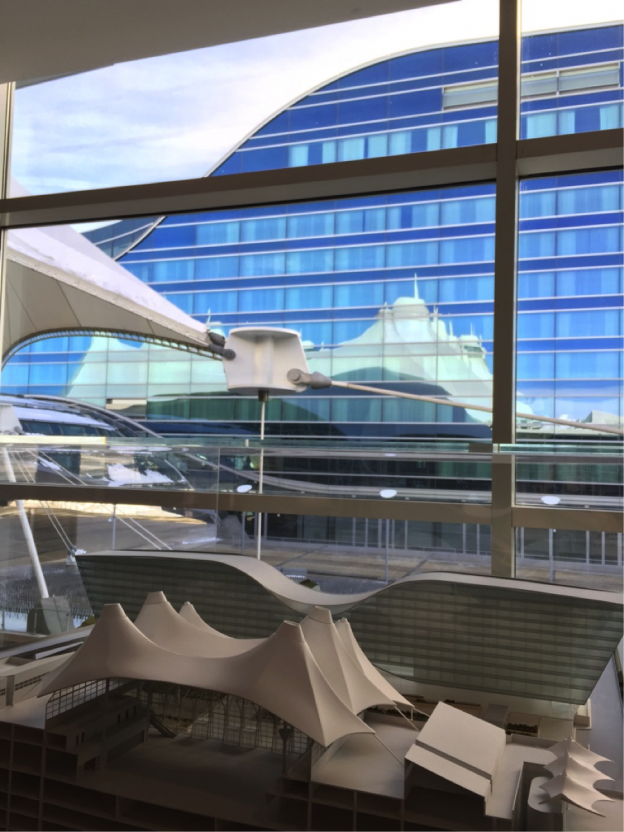I took this picture in the Denver International Airport (DIA) on my way to DC. It is a hand sculpted architecture model of the super hi-tech, globally forward thinking new hotel and entryway for the new light rail system that will very soon become a major thoroughfare between DIA airport and downtown Denver. Now, while I relish in the delight of public transportation, carbon offsets and the excitement of being able to do something productive during my many trips to DIA, it totally boggles my mind that this model was not 3D printed!

Doesn’t a 21st century looking airport, hotel and train system deserve a representation that embodies the best manufacturing has to offer? Nevermind the fact those tents are not straight, flat, or linear. Cutting those out of foam-core with an X-ACTO knife takes some serious talent.
This project seems ripe for 3D printing. There is complex geometry galore, a major and super obvious advantage of 3D printing. Having the luxury of reproducing the entire model on demand with no limit to quantity has major advantages. Want to impress your investors? Print this thing out and give it to them. That’s a pretty nice piece of artwork for the office.
Yet, I marvel and stand aghast that someone prepared this model by hand, out of many materials and paper-cuts, but did not use the original 3D CAD models to simply generate replicas of the new terminal, hotel, and train trifecta.
Here are my guesses why:
Large CAD integration is still a challenge for large aircraft companies, and so large facility integrators have not yet seen the light.
Even if the entire facility modelled in 3D, it is likely that there is not an integrated top assembly model of the entire system of: roads, hotel, train terminal, and connection structures from the hotel to the existing DIA terminal. CAD interoperability at this high level is still a dark art.
Building Information Modeling (BIM) is not what you think it is today.
Although defined as “Building Information Modeling,” BIM is a digital representation of physical and functional characteristics of a facility,” this does not mean a fully integrated and interoperable accurate 3D geometric representation of the entire facility is achievable.
Data formats are fundamentally different for CAD using for buildings.
One thing to understand is that a facility model (or coming from Revit), are actually really represented as 2D plus some Z (or third point location), but the thickness may not necessarily be represented with tessellated geometry. It is just attributes. For instance, a window is a rectangle (or maybe even 4 points) and some attributes about the window depth, R factor, and window type. We lack technology to translate this type of data between architecture/facility-type CAD systems (Revit and AutoCAD) to work intrinsically with the formats needed to feed a 3D printer. 3D printers typically draw their 3D geometry from an STL file (a file format that in dog years, is way too old for modern topology), but that is an article for another time.
How do you scale it?
The answer is: I don’t know. I’ve been down this path before with by brother, the architect and longtime modeling enthusiast. How do I represent a handrail that is 2.5 inches in diameter, but I need to scale the entire building to 1/100th, which would make the handrail equal to 0.025 inch, and that will be too damn fragile made from plastic.
The 3D printing architecture workflow
So over many years, and in general avoiding the architecture and facility CAD design market altogether, today, I come to the conclusion that creating scaled models of facilities certainly has benefit, but it takes a different skill set than traditional architecture firms most likely maintain.
The 3D printing architecture workflow is simply not the same workflow as it is for a product designer who has a plethora of automated conversion software options. So for the architect, it seems that manual recreation (or at a minimum seriously manipulated) is needed to move their design from native CAD into a file format supported by 3D printing. This technique is akin to hand constructing 3D models from cardboard and glue, the artisan merely uses different medium to achieve similar results.
So in case you care, and are paying attention to the benefits of 3D printing, and you have a hand in representing scaled-down buildings, it will soon become imperative that you solidify a repeatable workflow for converting architecture models into a file format useable by a 3D printer. If you go down this path, I am sure you will gain a competitive edge.
Resources to check out
- University of Austin advice for exporting from Revit to an STL file.
- Autodesk STL Exporter 2015, an app to export info from Revit.
- How to translate from Revit into STEP format.
- Describing water-tight and best practices for preparing a model for 3D printing.
After the basics: A 3D printing handbook

There's virtually no end to 3D printing resources for beginners. But what to do after you've mastered the basics is a little less clear. Let us help with this free eBook.





